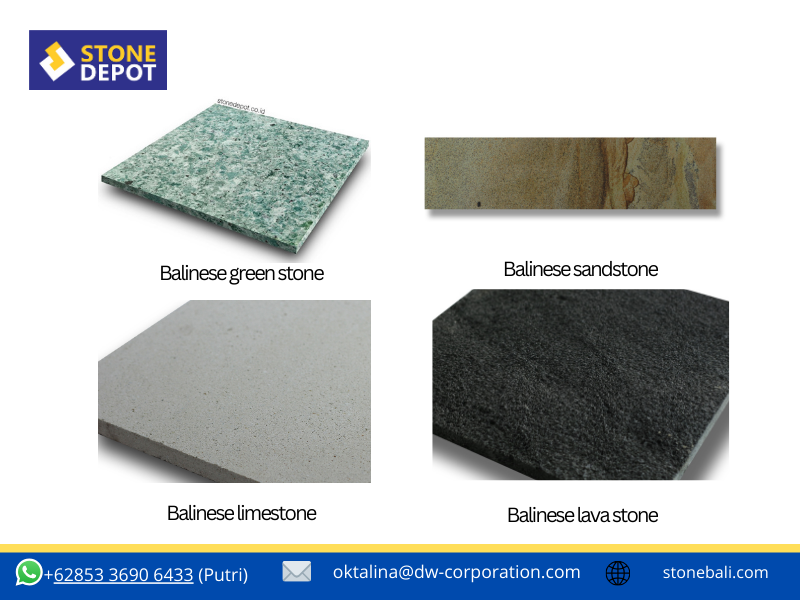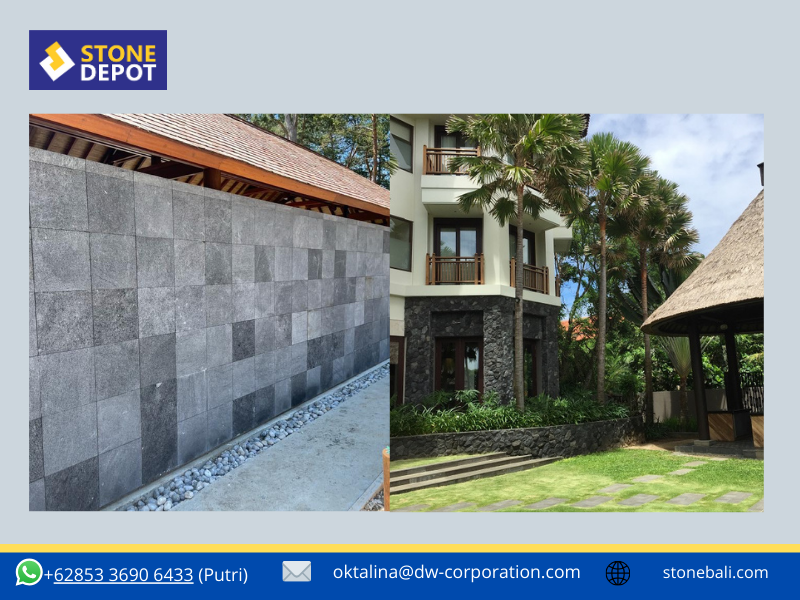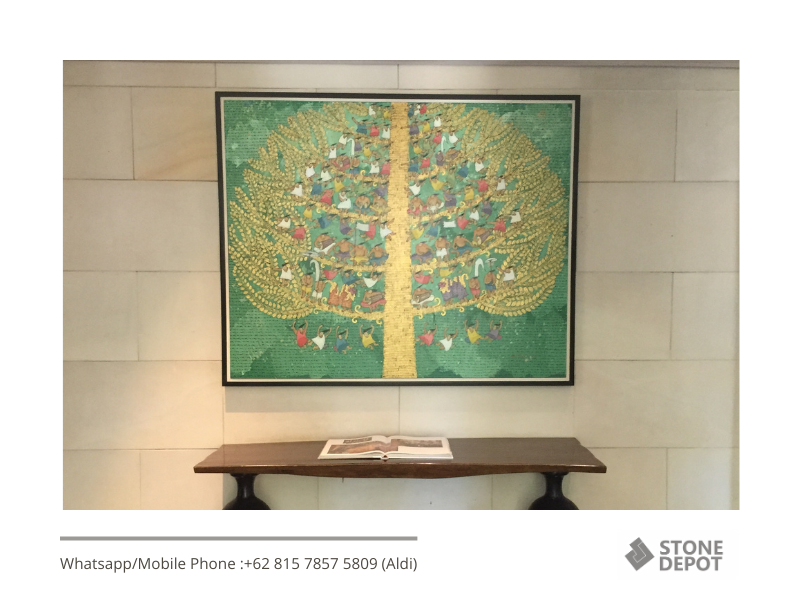Category: Bali Limestone
The perfection of Indonesia’s natural stone with the softy-textures and classy-colors is Bali Limestone, supplied by Stone Depot. Bali Limestone is the finest, durable, and versatile material. Our Bali Limestone often uses for floors, pavers, wall claddings, fireplaces, and stone carvings. The beauty of Bali Limestone supplied by Stone Depot comes in several ranges of colors such as the classic-white limestone and grey limestone or also known as Paras Kerobokan Stone. Explore our favorable Bali Limestone to brings the beauty of Bali nature into your style!
Siding is a great option to enhance the beauty and durability of your home’s exterior. Balinese stone has a unique combination of natural strength, cultural significance, and aesthetic appeal, which makes it stand out among the variety of materials available. This guide will help you choose the ideal Balinese stone for your walls.
Understanding Types of Balinese Stone

There are many types of Balinese stone, and each has unique characteristics. The most common types include:
1. Balinese Limestone
Balinese limestone is suitable for a calm and elegant look due to its soft texture and light, warm color. It is suitable for both modern and traditional designs.
2. Bali Sandstone
This stone comes in a variety of earthy tones, ranging from warm yellow to creamy white. Its rough, natural surface adds rustic charm to the outside.
3. Bali Lava Stone
Dark, porous Balinese lava stone is highly durable and heat resistant, making it perfect for creating bold and eerie images on your walls.
4. Bali Green Stone
This subtle green stone is very popular in resort and tropical designs. It is known for its cooling properties, which makes it ideal for warm regions.
How To Choose Balinese Stone for Your Design

The appearance of the wall covering is very important. The stone you choose must match the design of your home. For example, if you have a modern, minimalist home design, Balinese limestone or sandstone with its clean lines and subtle colors may be the best fit. On the other hand, if you prefer a more rustic or dramatic look, the rough texture of Balinese lava stone or sandstone can add the depth and character you need.
Although Balinese stone is known for its durability, different types require different care. For example, Balinese limestone is softer and may require more frequent sealing to protect it from moisture and stains. However, Bali lava stone is very hard and easy to care for, making it a great choice for homeowners who prefer to go stress-free.
When choosing a stone, consider the climate around you. Balinese lava rock and sand are very strong and resistant to water if you live in a very wet or high rainfall area.
In home design, sustainability is increasingly important. Balinese stone is definitely an environmentally friendly choice. This reduces the carbon footprint because it is sourced directly from nature and is not processed much. However, the environmental impact of transporting the stone to your location must be considered. Choose a provider that prioritizes ethical sourcing and sustainable practices.
The right choice of Balinese stone really depends on your budget. Due to their unique properties and limited availability, Balinese lava rock and limestone may be more expensive, but Balinese sandstone and limestone are usually cheaper. Since some types of stone may require longer lead times if they need to be imported, it is important to ensure that local suppliers are available.
Technical Guides Before Install Balinese Stone
Installing siding requires skill and precision, especially when using natural stone. To get optimal results, it is very important to hire professionals who have experience installing Balinese stone. Problems such as water leaks, stone movement, or uneven surfaces can arise as a result of improper installation, which can reduce the overall aesthetics of your coating.
You should request samples of the stone you are considering before making a final decision. This allows you to see how it looks in various lights and compare it to other materials used outside your home. You should also ask about the origin of the stone, as this can affect its quality and appearance.
Lastly, consider how the stone will age with time. The weather produces a beautiful patina on some stones, adding to their character and appeal. Others may require regular sealing and cleaning to maintain a clean appearance.
Choosing the right Balinese stone for wall cladding is an important decision that can impact the aesthetics and value of your home. Whether you choose elegant Balinese limestone, rustic Balinese sandstone, or Balinese lava stone, you can make the right choice that will enhance the beauty and longevity of your home.
Wether you are interested in using Balinese stone of Stone Depot for your Living Space, please contact us by clicking the following Whatsapp link: https://wa.me/6285336906433 (Putri) or email: [email protected].

How to Install Bali Limestone on Exterior – Limestone is a popular building material used in both interior and exterior applications. It’s a natural stone that’s strong, durable, and can add a touch of elegance to any property. If you’re considering installing limestone on your exterior, it’s important to follow the proper installation procedures to ensure that it’s done correctly.
A Step-by-Step Guide on How to Install Bali Limestone

Step 1: Measure the Area
The first step in installing limestone on your exterior is to measure the area that needs to be covered. This will help you determine how much limestone you’ll need to purchase. Be sure to measure the height and width of the area, and add an extra 10% to account for cuts and waste.
Step 2: Prepare the Surface
The surface where the limestone will be installed must be clean and free of debris. Use a pressure washer to remove any dirt, dust, or grime. Let the surface dry completely before moving on to the next step.
Step 3: Apply the Adhesive
Before installing the limestone, you’ll need to apply an adhesive to the surface. Choose an adhesive that’s specifically designed for use with limestone and follow the manufacturer’s instructions for mixing and application. Apply the adhesive in a thin, even layer using a notched trowel.
Step 4: Install the Bali Limestone Tiles
Now it’s time to install the limestone. Carefully place each piece of limestone onto the adhesive, pressing it firmly into place. Use spacers to ensure that each piece is evenly spaced from the next. If you need to cut any pieces to fit around windows or doors, use a wet saw or angle grinder to make the cuts.
Step 5: Grout the Joints
Once the limestone is installed, it’s time to grout the joints. Choose a grout that matches the color of the limestone and follow the manufacturer’s instructions for mixing and application. Use a grout float to apply the grout, making sure to fill in all the gaps between the limestone pieces.
Step 6: Clean the Surface
After the grout has dried, use a damp sponge to clean the surface of the limestone. Be careful not to apply too much pressure, as this can damage the grout. Once the surface is clean, allow it to dry completely.
Step 7: Seal the Bali Limestone
Finally, it’s important to seal the limestone to protect it from moisture, stains, and other damage. Choose a sealer that’s specifically designed for use with limestone and follow the manufacturer’s instructions for application. Apply the sealer in a thin, even layer using a paintbrush or sprayer. Allow the sealer to dry completely before exposing the limestone to any moisture.
Installing Bali limestone tiles on your exterior can add beauty and durability to your property. By following these simple steps, you can ensure that your limestone is installed correctly and will last for many years to come. Remember to choose the right adhesive, grout, and sealer for your specific project, and don’t hesitate to seek the advice of a professional installer if you’re unsure about any aspect of the installation process.
If you are interested in using Bali Limestone from Stone Bali for your Living Space, please contact us by clicking the following Whatsapp link: https://wa.me/6285336906433 (Putri) or email: [email protected]
Nestled in the heart of Bali’s tropical paradise, Sofitel Bali Nusa Dua Beach Resort stands as a symbol of luxury and environmental responsibility. This exceptional resort has recently incorporated white limestone wall cladding, a choice that combines opulence with eco-friendliness. In this article, we will explore the charm of this sustainable cladding and how it has transformed Sofitel Nusa Dua Bali into an exquisite eco-friendly haven.
The Enchantment of Bali and Sofitel Nusa Dua
Bali, celebrated for its unspoiled coastlines and luxuriant scenery, has perennially beckoned to wanderers in quest of an ideal retreat. The Sofitel Bali Nusa Dua Beach Resort, ensconced in the vivacious environs of Nusa Dua, bestows a taste of this heaven. The resort’s allure is not solely contingent upon its locale but is also intricately woven into its exceptional design preferences.
White Limestone Wall Cladding: A Masterpiece of Sustainability

At the heart of this eco-friendly resort lies the elegant choice of white limestone wall cladding. This selection sets it apart by combining aesthetics with environmental responsibility. White limestone, celebrated for its timeless beauty and eco-friendliness, graces the resort’s exterior.
The use of white limestone in the resort’s wall cladding adds a touch of sophistication and timeless elegance to the tropical landscape. The pristine white color creates a stunning contrast with the lush green surroundings, enhancing the visual appeal.
One of the most remarkable features of white limestone is its environmental responsibility. It is a sustainable choice that can endure the test of time and Bali’s climate, all while maintaining its pristine appearance. This makes it an ideal choice for a resort that values both aesthetics and eco-friendliness.
Enhancing the Guest Experience
White Limestone: Aesthetic Serenity and Eco-Friendliness
White limestone wall cladding is not just an architectural choice; it’s an experience enhancer. Guests at Sofitel Bali Nusa Dua Beach Resort are treated to a visually stunning environment that is also eco-friendly and soothing.
The choice of white limestone reflects the resort’s commitment to environmental responsibility. It’s not just about aesthetics but also about preserving Bali’s natural beauty and blending it with luxury.
Inspiring Future Environmental Trends
Sofitel Bali Nusa Dua Beach Resort’s choice of white limestone wall cladding is a pioneering step towards sustainable design. Its timeless aesthetics and eco-friendly attributes might inspire future projects to follow a similar path of responsible luxury.
In conclusion, Sofitel Bali Nusa Dua Beach Resort, with its choice of white limestone wall cladding, has redefined luxury and sustainability in architectural design. This elegant material not only enhances the resort’s visual appeal but also underscores its commitment to environmental responsibility. By combining aesthetics with eco-friendliness, the resort has set a high standard for future architectural endeavors in this tropical paradise.
If you are interested in using White Limestone for your wall cladding project, please contact us by clicking the following Whatsapp link: https://wa.me/6285336906433 (Putri) or email: [email protected]

